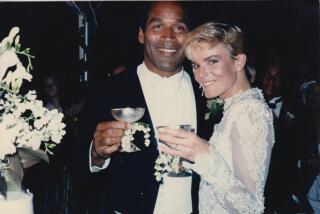Simpson’s Defense Can Use Theory on Evidence
- Share via
Boosting the defense effort to argue that O.J. Simpson was framed for murder, a judge ruled Friday that lawyers in the civil trial can present their theory that key pieces of evidence--including a blood-smeared glove and socks--may have been planted.
Superior Court Judge Hiroshi Fujisaki warned defense attorneys not to get carried away with unsupported “grandiose theories” that could mislead jurors.
But he allowed the defense to argue that blood could have been planted in Simpson’s Ford Bronco, on socks and a glove recovered from his estate, and on the back gate at the murder scene on Bundy Drive.
The ruling gives the defense a chance to reprise the tactic that proved so persuasive in the criminal trial. The 12 jurors who heard the criminal case clearly believed that something was wrong with the physical evidence against Simpson. Many of the potential jurors in the civil case have indicated that they, too, question the integrity of the blood evidence.
To raise the specter of planting, defense attorneys are relying on testimony and documents that they find suspicious.
They will note that several experts examined the socks recovered from the foot of Simpson’s bed in the early days of the investigation--and none of them reported seeing blood. It was not until August, two months after the slayings, that a criminalist spotted blood, which turned out to contain DNA consistent with that of victim Nicole Brown Simpson. Similarly, the defense will contend that a photo taken early in the investigation showed no blood on the back gate of Nicole Simpson’s condo. A drop with DNA matching O.J. Simpson’s was collected from the gate two weeks after the killings.
Relatives of the two victims, who are pressing the civil case against Simpson, tried to persuade Fujisaki that the defense should not be allowed to make “inflammatory” inferences of a frame-up just because some evidence was collected late. The planting theory, plaintiffs’ attorneys argued in court papers, was nothing more than a “charade” spun out of wild speculation and absurd conjecture.
Fujisaki, however, disagreed.
UCLA law professor John Wiley said Fujisaki’s decision implies that Simpson’s side “has a logical line of argument with at least some support from the evidence.”
Wiley and other analysts termed the judge’s decision important, but not surprising. They had figured that Fujisaki would be loathe to gut the defense case, especially because the planting allegations, however fuzzy, proved plausible enough to win Simpson swift acquittals in last year’s criminal trial.
“This was something [Fujisaki] had to do,” civil litigator Brian Lysaght said. “It would have tainted the verdict beyond belief if the defense had not been allowed to argue planting. I think the judge made the right call.”
Fujisaki seemed most reluctant to let the defense argue the planting theory with regard to the right-handed glove found in back of Simpson’s guest house. That glove, discovered by former LAPD Det. Mark Fuhrman, was stained with blood later described as consistent with DNA from O.J. Simpson and victims Nicole Brown Simpson and Ronald Lyle Goldman.
“With this item, the court finds that the evidence is very slim to support a planting theory,” Fujisaki said. But he agreed to let the defense raise the issue anyway, saying there was “sufficient basis” to question the glove since Fuhrman last week pleaded no contest to a felony perjury charge stemming from his testimony in the Simpson criminal trial.
“It seems to me that Fujisaki has given far too much weight to Fuhrman’s perjury plea in his own mind,” UCLA law professor Peter Arenella said. “Fuhrman’s acknowledgment that he lied [about using a racial slur] . . . has very little relevance to whether there’s one shred of evidence that he planted that glove.”
But as Simpson’s lawyers delight in pointing out, jurors are specifically instructed that they can disregard a witness’s entire testimony if they find that he or she lied on any one point. So Fuhrman’s credibility is very much at issue--including his story about finding the glove. In that context, other legal analysts said, Fujisaki was correct to allow the defense to raise the specter of planting.
Although Fujisaki’s rulings on the glove, socks and back gate blood were all victories for the defense, the judge did deal Simpson’s team a few setbacks.
He rejected a defense plea to let jurors tour the crime scene and Simpson’s yard. And he restricted the defense’s opening statement, saying lawyers cannot apply the planting theory to every piece of incriminating evidence.
The defense cannot, for example, suggest planting to explain several items found at the murder scene, including a knit cap flecked with hairs and fibers linked to Simpson, a trail of blood drops containing DNA consistent with Simpson’s, and a left-handed leather glove matching the one found at Simpson’s estate. They are also barred from suggesting that blood drops in Simpson’s driveway and foyer were planted.
Finally, they cannot argue that planting accounted for one of the stains collected from the Bronco’s console--a blood smear that contained DNA consistent with Simpson’s and faint markers that could be linked to Goldman.
Fujisaki did permit the defense to argue that a second series of Bronco blood splotches could have been planted. Those stains were collected 10 weeks after the slayings--and after the Bronco had been broken into by a tow truck driver while it was in police custody. DNA testing showed that the stains were consistent with blood from Simpson and both victims.
More to Read
Sign up for Essential California
The most important California stories and recommendations in your inbox every morning.
You may occasionally receive promotional content from the Los Angeles Times.













